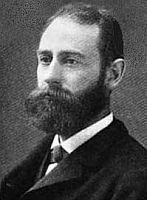 When Nathanael Green Herreshoff was around 16, he began to work for his elder brother, John Brown Herreshoff, in his boat yard in Bristol, RI. To work as an apprentice was a traditional way to learn the skills and techniques to become a successful yacht or ship designer and builder. Nathanael Herreshoff took a different course, however. At 19 her went to the Massachusetts Institute of technology and earned a degree in mechanical engineering. After graduation, he took a position with the Corliss Steam Engine Company in Providence, Rhode Island and worked for the firm for eight years. At the age of 30 in 1878, Nathanael returned to Bristol and became a partner with his elder brother in the Herreshoff Manufacturing Company.
When Nathanael Green Herreshoff was around 16, he began to work for his elder brother, John Brown Herreshoff, in his boat yard in Bristol, RI. To work as an apprentice was a traditional way to learn the skills and techniques to become a successful yacht or ship designer and builder. Nathanael Herreshoff took a different course, however. At 19 her went to the Massachusetts Institute of technology and earned a degree in mechanical engineering. After graduation, he took a position with the Corliss Steam Engine Company in Providence, Rhode Island and worked for the firm for eight years. At the age of 30 in 1878, Nathanael returned to Bristol and became a partner with his elder brother in the Herreshoff Manufacturing Company.
The unusual aspect of the partnership was that while his older brother, John Brown, known in the family as J.B., was highly successful boatbuilder, he was also blind. His blindness had not prevented him from being a skilled manager and a gifted businessman. The addition of the Nathanael as a partner added a skilled designer and engineer to the firm.
The two brothers were initially very busy building steam torpedo boats for the US navy and for other navies around the world. Nathanael also quickly became known as a yacht designer. With J.B. running the business and Captain Nat, as he became known, handing the designs, Herreshoff Manufacturing built sailing yachts for America’s elite, including Jay Gould, William Randolph Hearst, John Pierpont Morgan, Cornelius Vanderbilt III, Harold Stirling Vanderbilt, William Kissam Vanderbilt II, Harry Payne Whitney and Alexander Smith Cochran.
Captain Nat’s designs included boats that successfully defended the America’s Cup six times: Vigilant in 1893, Defender in 1895, Columbia in 1899 and 1901, Reliance in 1903, and Resolute in 1920. The designs were innovative for their time. Defender featured steel-framing, bronze plating up to the waterline and aluminum topsides. The boat was subject to the then little understood galvanic corrosion, but still managed to defeat the the New York Yacht Club’s Vigilant and to then go on to successfully defend the cup against British challenger Valkyrie III.
Nathanael Herreshoff’s designs were often well ahead of their time. In 1876, Nat Herreshoff designed the catamaran yacht Amaryllis which won that year’s New York Centennial Regatta. Following the victory, multihulls were banned from organized sailing competitions. In 1891, Herreshoff’s Dilemma featured a fin keel with a streamlined bulb and a spade rudder. The design won ever race it entered and was significantly influential. Over 100 more fin keel yachts were built within the next few years. In 1897, many yacht clubs adopted measurement rules that penalized the design in the attempt to make other boats competitive.
In 1902, Captain Nat developed the “Herreshoff Rule,” later called the Universal Rule, which was used for rating yacht’s in the America’s Cup from 1914 to 1937.
Nathanael Herreshoff designed over 2,000 vessels in a 72 year career and earned the nickname, the “Wizard of Bristol.” He died in 1938 at the age of 90.
